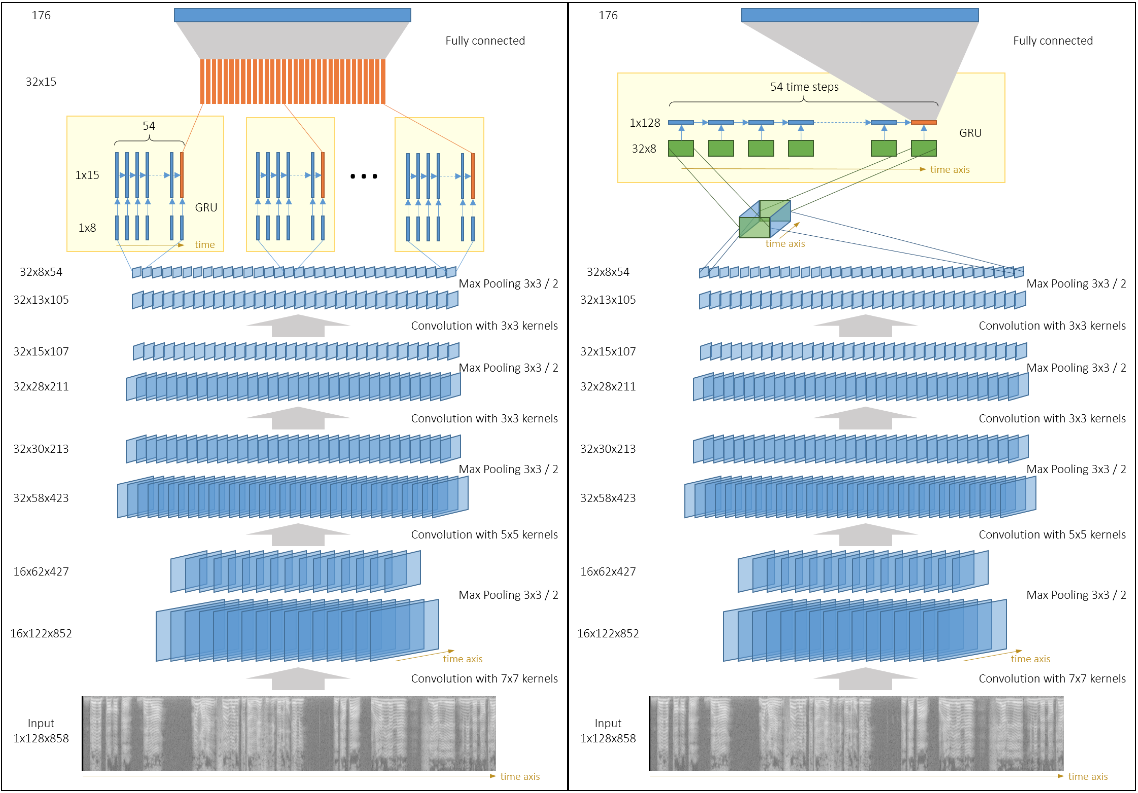[Tensorflow] RNN - 04. Work with CNN for Text Classification
Ref: Combining CNN and RNN for spoken language identification
Ref: Convolutional Methods for Text
[1] CONVOLUTIONAL, LONG SHORT-TERM MEMORY, FULLY CONNECTED DEEP NEURAL NETWORKS
[2] Efficient Character-level Document Classification by Combining Convolution and Recurrent Layers
结合此文,对sentiment prediction做进一步的性能提升。
一个近似的例子:https://github.com/LopezGG/NN_NER_tensorFlow/blob/master/network.py
#Embedding layer (is always built on CPU. There is bug that makes embedding fail on GPU)
with tf.device('/cpu:0'), tf.name_scope("char_embedding"):
#plus 1 becuase 0 is for unknown char
self.W_char = tf.Variable(tf.random_uniform([char_vocab_size+1, char_embedd_dim],-1,1),trainable=True, name="W_char")
self.char_embedding_placeholder = tf.placeholder(tf.float32, [char_vocab_size+1, char_embedd_dim])
char_embedding_init = self.W_char.assign(self.char_embedding_placeholder)
self.embedded_char = tf.nn.embedding_lookup(self.W_char, self.input_x_char_flat,name="embedded_char") #shape [batch_size,max_char_per_word*sequence_length,char_embedd_dim]
self.embedded_char_dropout =tf.nn.dropout(self.embedded_char, self.dropout_keep_prob,name="embedded_char_dropout")
#Add CNN get filters and combine with word
with tf.name_scope("char_conv_maxPool"):
filter_shape = [filter_size, char_embedd_dim, num_filters]
W_conv = tf.Variable(tf.truncated_normal(filter_shape, stddev=0.1), name="W_conv")
b_conv = tf.Variable(tf.constant(0.1, shape=[num_filters]), name="b_conv")
conv = tf.nn.conv1d(self.embedded_char_dropout,
W_conv,
stride=1,
padding="SAME",
name="conv") #will have dimensions [batch_size,out_width,num_filters] out_width is a function of max_words,filter_size and stride_size #(?, 3051, 20)
#out_width for same padding iwth stride 1 given by (max_char_per_word*sequence_length)
print("conv.get_Shape(): ",conv.get_shape())
# Apply nonlinearity TODO: Test without relu
#h = tf.nn.bias_add(conv, b_conv,name="add bias")#does not change dimensions
h_expand = tf.expand_dims(conv, -1)
print("h_expand.get_Shape(): ",h_expand.get_shape())
pooled = tf.nn.max_pool(
h_expand,
#[batch, height, width, channels]
ksize=[1,sequence_length * max_char_per_word,1, 1], #On the batch size dimension and the channels dimension, ksize is 1 because we don't want to take the maximum over multiple examples, or over multiples channels.
strides=[1, max_char_per_word, 1, 1],
padding='SAME',
name="pooled")
#print("pooled.get_Shape(): ",pooled.get_shape())
#[batch_size,(max_char_per_word*sequence_length), num_filters, 1] --> [batch, sequence_length, num_filters] , same as word_embedding layer (?, 113, 20, 1) --> (?, 113, 20)
self.char_pool_flat = tf.reshape(pooled, [-1,sequence_length,num_filters],name="char_pool_flat")
#print("self.char_pool_flat.get_shape(): ",self.char_pool_flat.get_shape())
#[batch, sequence_length, word_embedd_dim+num_filters]
self.word_char_features = tf.concat([self.embedded_words, self.char_pool_flat], axis=2) #we mean that the feature with index 2 i/e num_filters is variable
#print("self.word_char_features.get_shape(): ",self.word_char_features.get_shape())
self.word_char_features_dropout =tf.nn.dropout(self.word_char_features, self.dropout_keep_prob,name="word_char_features_dropout")
Combinations of CNN and RNN
The general architecture of these combinations is a convolutional feature extractor applied on the input, then some recurrent network on top of the CNN’s output, then an optional fully connected layer on RNN’s output and finally a softmax layer.
The output of the CNN is a set of several channels (also known as feature maps). We can have separate GRUs acting on each channel (with or without weight sharing) as described in this picture (Left).
Another option is to interpret CNN’s output as a 3D-tensor and run a single GRU on 2D slices of that tensor, picture (Right).

The latter option has more parameters,but the information from different channels is mixed inside the GRU, and it seems to improve performance. 【后者貌似好】
This architecture is similar to the one described in this paper[1] on speech recognition,
except that they also use some residual connections (“shortcuts”) from input to RNN and from CNN to fully connected layers.
It is interesting to note that recently it was shown that similar architectures work well for text classification[2].
| Network | Accuracy | Notes |
|---|---|---|
| tc_net_rnn | 92.4 | CNN consists of 3 convolutional blocks and outputs 32 channels of size 104x13. Each of these channels is fed to a separate GRU as a sequence of 104 vectors of size 13. The outputs of GRUs are combined and fed to a fully connected layer |
| tc_net_rnn_nodense | 91.94 | Same as above, except there is no fully connected layer on top of GRUs. Outputs of GRU are fed directly to the softmax layer |
| tc_net_rnn_shared | 96.96 | Same as above, but the 32 GRUs share weights. This helped to fight overfitting |
| tc_net_rnn_shared_pad | 98.11 | 4 convolutional blocks in CNN using pad=2 instead of ignore_broder=False(which enabled CuDNN and the training became much faster). The output of CNN is a set of 32 channels of size 54x8. 32 GRUs are applied (one for each channel) with shared weights and there is no fully connected layer |
| tc_net_deeprnn_shared_pad | 95.67 | 4 convolutional block as above, but 2-layer GRUs with shared weights are applied on CNN’s outputs. Overfitting became stronger because of this second layer |
| tc_net_shared_pad_augm | 98.68 | Same as tc_net_rnn_shared_pad, but the network randomly crops the input and takes 9s interval. The performance became a bit better due to this |
| tc_net_rnn_onernn | 99.2 | The outputs of a CNN with 4 convolutional blocks are grouped into a 32x54x8 3D-tensor and a single GRU runs on a sequence of 54 vectors of size 32*8 |
| tc_net_rnn_onernn_notimepool | 99.24 | Same as above, but the stride along the time axis is set to 1 in every pooling layer. Because of this the CNN outputs 32 channels of size 852x8 |
The second layer of GRU in this setup didn’t help due to the overfitting.
It seems that subsampling in the time dimension is not a good idea. The information that is lost during subsampling can be better used by the RNN.
In the paper on text classification[2] by Yijun Xiao and Kyunghyun Cho, the authors even suggest that maybe all pooling/subsampling layers can be replaced by recurrent layers.
训练技巧
These networks were trained using SGD with momentum only. The learning rate was set to 0.003 for around 10 epochs, then it was manually decreased to 0.001 and then to 0.0003. On average, it took 35 epochs to train these networks.
Ensembling
The best single model had 99.24% accuracy on the validation set. We had 33 predictions by all these models (there were more than one predictions for some models, taken after different epochs) and we just summed up the predicted probabilities and got 99.67% accuracy. Surprisingly, our other attempts of ensembling (e.g. majority voting, ensemble only on some subset of all models) didn’t give better results.



